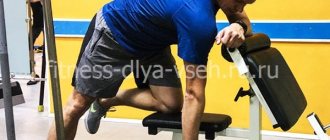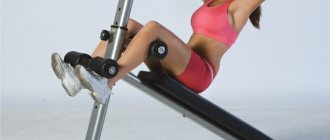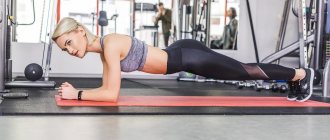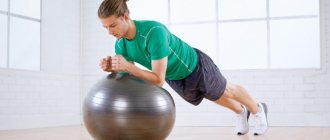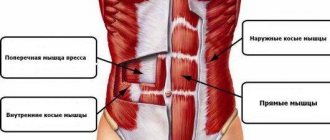What muscles can you pump up?
This type of training belongs to the Pull category and is an isolating exercise. The main goal is to strengthen the lower abdomen (abs). The main muscles involved when performing a supine leg raise are the following:
- internal pelvic muscles - iliopsoas;
- paired group of synergist muscles - pectoral, latissimus dorsi and gluteal;
- core muscles - stabilizers of the shoulders, abdomen, back and hips;
- rectus, medial, lateral and middle muscles of the thigh - quadriceps.
Additionally, read how to pump up your lower abs.
Raising legs while hanging on a horizontal bar - benefits
The benefits of hanging leg raises have been proven many times, so if you decide to start training, don’t hesitate to start. Among the main advantages of this exercise are:
- effective impact on the press, especially pronounced for the lower part and the most lagging areas;
- strengthening core muscles;
- visual change and tightening of the lower abdomen, giving it an aesthetic appearance;
- prevention of umbilical and inguinal hernias;
- strengthening the abdominal walls and maintaining internal organs in normal condition;
- promotes increased energy expenditure, which leads to fat burning, which is why hanging leg raises are often included in weight loss workouts;
- forms correct posture
Moreover, if you do the exercise correctly, you can achieve a beneficial effect on the spine.
Due to the extended position (by the way, chiropractors often resort to the “pulling” technology), you can get rid of pain in the back.
Contraindications
Before considering how to do hanging leg raises, I recommend that you familiarize yourself with the contraindications for exercise. This exercise can be done by almost anyone, but you should choose a different training option in several cases:
- the presence of vertebral hernias;
- recent shoulder or spine injuries;
- painful sensations in the lumbar region when performing activities.
If you have a contraindication, it is better to consult your doctor.
You may be allowed to train, as recommendations are usually provided on a case-by-case basis.
Execution technique
Consider the classic performance of lying leg raises:
- Lay out a gymnastics mat. Take a lying position on your back.
- Relax as much as possible. Place your hands under your lower back, palms down (you can place a small cushion under your lower back). Straighten your legs and close them together. This position is the starting point.
- As you exhale, raise both legs up, maintaining a 90-degree angle. Don't bend your knees. At the end point, linger for 1-2 seconds.
- As you inhale, slowly lower your lower limbs, trying not to touch the surface. The approximate distance from the floor to the heels should be 15-20 cm.
- Repeat the required number of approaches.
You can clearly see the technique of performing the exercise in the video below:
Lying on your back leg raises
Lying on your back leg raises
- an exercise aimed at working mainly the lower abdominals
(
part of the rectus abdominis muscle). In addition to the abdominal muscles, the quadriceps femoris muscle is also involved in the work. There are several options for performing leg raises, each of which differs in the degree of effectiveness and level of safety for the lower back.
These criteria include:
- Body position
. Holding the body up creates an additional static load on the upper part of the rectus abdominis muscle; - Hand position
. If your palms are placed under the lower part of the buttocks, they will slightly lift the pelvis, which will give them an inclined position. A slightly raised pelvis makes it possible to tightly press the lower back to the floor and protect it from the 2 most traumatic phases - at the beginning and end of the lift; - Leg position
. The more the legs are straightened, the greater the amplitude of the execution. The greater the amplitude, the more difficult and effective the exercise, but the greater the load on the lower back; - Using weights
(weights) or a gymnastic ball, which additionally holds the inner thigh in static tension. This is an advanced level of training. The use of weights is aimed at increasing the volume of abdominal muscle mass (those same cubes); - Bench angle
. The lower the bench is inclined, the greater the load on the abdominal muscles. A more difficult option is to lie on a bench, leaving your legs hanging.
Lying leg raises can be performed simultaneously, alternately or sequentially
. In principle, the effectiveness of performing each version of leg lifting is the same, the difference is in the level of safety for the lumbar region. The choice of one or another implementation option also depends on the level of training.
| Exercise characteristics | |
| Type of exercise: | basic |
| Main working muscles: | lower abdominals |
| Additional working muscles: | quadriceps femoris muscle |
| Difficulty of the exercise: | light |
Starting position
: • lie on your back. Place your hands along your body, palms down. Press your head, shoulder blades, lower back and buttocks to the floor. The position of the arms and body can vary, and the lower back must be pressed to the floor; • if you perform the exercise while holding your body in weight, then place your hands behind your head; • Straighten and extend your legs, touching your heels to the floor. Alternatively, your legs can be slightly bent at the knees.
Exercise technique
: • being in the starting position, using the efforts of the abdominal muscles (especially the lower part of the rectus abdominis muscle), exhaling, raise your legs until the hips make a right angle with the body; • slowly, controlling the movement, inhaling, return your legs to their original position; do not lift your lower back off the floor. It should be pressed throughout the entire approach; • As soon as your heels touch the floor, raise your legs again. Do the required number of repetitions.
Recommendations for performing lying leg raises
Don't let your abdominal muscles relax.
Watch your lower back position. She must remain pressed. This is a prerequisite for her safety. Watch the video on the topic
:
Variations
In addition to the typical exercise, there are several variations. Each type of training is designed for people with different sports backgrounds (beginners, professional athletes and people undergoing rehabilitation measures):
1. Alternating leg raises for beginners. Lie down on a gymnastics mat. Straighten your back and legs. You can place your hands under the lower back or behind your head, clasping them together.
Movements: exhaling, raise one leg up to 45-60 degrees. Hold for 2 seconds. Lower your leg completely, touching the heel to the surface. As soon as the lower limb has taken the starting position, raise the opposite leg to the same angle. It is allowed to raise your head during the first few workouts, this will lighten the load a little.
2. Restorative exercise during the rehabilitation period (after surgery of the abdominal cavity, pelvic area, etc.). Lie down on the mat and completely relax. Straighten your back. Place the cushion under your head in the neck area. Keep your arms along your body. Your legs can be slightly bent at the knee. As you exhale, lift one leg, reaching an angle of 90 degrees. Hold for 2 seconds. As you inhale, return to the starting position. Repeat the same with the other limb. At the top point, try to gradually straighten your knee.
Before performing this exercise, you should consult a specialist. The doctor will prescribe the required load. Independent training is strictly prohibited. Leg lifts are contraindicated for pregnant women, since the main load falls on the lower abdomen, and an overly toned abs makes labor difficult.
3. Simultaneously raise your legs to an angle of 45-60 degrees. This exercise option is suitable for athletes with average physical fitness.
The initial position is identical to the classic version, i.e. horizontally. Raise your legs simultaneously to an angle of 45 or 60 degrees. At the end point, fixate for 2-3 seconds. As you inhale, return to the starting position without your heels touching the surface, maintaining a distance of 2-3 centimeters.
To simplify the exercise, full contact of the legs with the surface is allowed. This way the abs will rest, but this makes the workout less effective.
4. Weighted leg raises. If your abdominal muscles are developed and there is a need to increase the load, this variation is just for you. The technique is similar to the classical one. Only here it is necessary to attach a weighting agent to each lower limb or hold the dumbbell with your ankles. The weight of the weighting agent is selected for each athlete individually. Raising the legs is carried out to an angle of 45 or 60 degrees. Do not touch the floor with your feet, but leave a distance of 3-4 centimeters. Perform the required number of approaches and repetitions.
5. Lying on your stomach. Starting position: lie on your stomach. Stretch your arms forward. Close your legs together. As you exhale, alternately lift your lower limbs up. Try to fix your hips as much as possible. They are not allowed to be torn off the floor.
6. Leg raises while lying on your side. Lie on your side. Bend your arm at the elbow and rest on it. Legs straight. Technique: while exhaling, raise the lower limb as high as possible. Make sure that your leg does not bend at the knee joint. Perform the required number of times and change the position of your body, turning over to the other side.
Each leg lift option can be performed on training equipment or on a regular flat bench. The training does not require additional equipment, so it can easily be done at home.
Leg raise[edit | edit code]
Source: Strength Training for Girls
.
Illustrated manual. Posted by
Frédéric Delavier 2021
Areas of Muscle Activation When Performing Leg Raises
Not all variations of leg raises fall into the same exercise category. Those options in which the legs remain straight belong to the category of isolating exercises. Those variations in which you bend your legs belong to the category of basic exercises. Leg raises work not only your abdominal muscles, but also your hip flexors. If done correctly, this exercise will work all the abdominal muscles, especially the lower part.
Performance
Leg raises can be performed lying on the floor (easy option), sitting (difficult option) or hanging on a bar (hardest option).
- Lying leg raises
. Lie with your back on the floor, extend your arms along your torso, bend your legs at an angle of 90 degrees, lift your buttocks, and then your lower back. Raise your legs slowly and stop when your upper back begins to lift off the floor. Imagine that your upper abdominal muscles are touching your chest muscles. Although the actual contact does not occur, imagining it will help you perform the movement correctly. Hold the top position for 2 seconds, keeping your abdominals tense. Slowly return to the starting position. To maintain constant muscle tension, do not lower your buttocks to the floor, but stop a few centimeters from it. The head should be on the floor throughout the entire exercise. Don't move your neck. You can also do an option in which your legs are raised very low above the floor, but this is not very effective for strengthening the abdominal muscles.
- Seated leg raises.
Sit on a bench and grab the edge to maintain your balance. Bend your knees to a 90-degree angle and lift your lower abdomen so that it pushes out your upper abdominal muscles. At the same time, you should round your back, but not raise your legs. The full range of motion is only a few centimeters. Hold the top position for 2 seconds, keeping your abdominals tense. Slowly return to the starting position and repeat the exercise. The main problem with this option is that it can be difficult to push out the upper abdominal muscles. In addition, the load placed on the lower back limits the mobility of the spine. And if you fail to lift up correctly, most of the work will be done by other muscles other than your abdominals.
- Hanging leg raises.
This is the most difficult option. Hang with straight arms on the bar, grasping it with an overhand grip shoulder-width apart. Raise your legs so that your thighs are parallel to the floor and your legs make a 90-degree angle with your torso. You can keep your legs straight (this makes the exercise more difficult) or bend them at the knees, bringing your shins to your hips (this makes the exercise easier). Advanced variation: Start with your legs straight, and when you get tired, bend them for a few extra reps. Using your lower abdominal muscles, lift your pelvis as you bring your knees toward your chest. Try to raise your pelvis as high as possible. Hold this pose for a second, then lower your pelvis. Do not lower your legs below a position where your thighs are parallel to the floor. The hardest part of this exercise at first will be not to swing your body too much. With practice, you will learn to stabilize its position. An alternative is to use specially designed benches that support the back, allowing the body to stabilize while hanging.
Advantage
- Working the lower abdominal muscles is quite difficult. Leg raises are best for this.
Flaw
- This exercise is easier to do incorrectly than with correct technique. If you feel a pulling tension in your lower back, it means you are doing it incorrectly. Be prepared that it will take some time before you can tighten your lower abdominal muscles.
Overuse of the hip flexors can slip discs and cause pain if they are already damaged.
Recommendation
- When you arch your back, it’s not your abdominals that start working, but other muscles; in addition, the intervertebral discs of the lower back are pinched. The goal of this exercise is not to lift your legs, but to lift your hips first.
- Lying leg raise
- Seated Leg Raise
- Hanging leg raises on the bar
- Hanging leg raises on a machine
Common mistakes
Beginning athletes, when performing the exercise of raising legs in a horizontal position, often make a number of mistakes. This not only affects the effectiveness of the workout, but also increases the risk of injury (remember that the spine and lower back are involved in the exercise).
Let's look at the main mistakes:
- Performing the exercise without a gymnastic mat. If you lie on a cold floor without equipment, and your body is hot during the exercise, the risk of lower back inflammation increases. Exercises should be performed in a well-ventilated area.
- Sudden rise and fall of legs. If the exercise is performed at an incorrect and fast pace, inconsistent muscle contraction occurs. To extinguish the resulting inertia, more strength and energy will be required. You simply won't be able to complete the required number of repetitions and will get tired quickly.
- Incorrect execution technique. Each lifting of the legs is accompanied by a delay at the top point for several seconds. This is necessary for the full effectiveness of the training.
- Continuing to perform the workout through strength and back pain. If at the first movements you experience pain in the back area, then you are advised to stop exercising and rest. If the pain recurs, reduce the load and contact an instructor.
- Incorrect leg angle. Don't try to prove to anyone or yourself that you have excellent stretching. The elevation angle is determined to the best of your ability. Otherwise, you risk getting a sprain.
- Workouts after meals. Remember, no physical exercise should begin immediately after eating. It is necessary to wait at least an hour to avoid nausea and vomiting.
- Initial exercises with increased loads. Start each workout with light exercises aimed at warming up the muscles. After this, do the easiest option (lifting your legs one at a time), gradually increasing the load.
Advantages and disadvantages
Lying leg raises are a common exercise in bodybuilding and fitness. But like most movements, it has both pros and cons.
Among its obvious advantages:
- Ease of technique and accessibility for any level of training
- Working out the entire length of the rectus abdominis muscle
- Possibility to do the exercise in different conditions
Leg raises for abs require no equipment and can be done anywhere - on the floor at home, in the gym, and even outside.
For the version lying on the ground, you will need a gymnastic mat, but you can do “street” leg lifts while lying on a bench.
Among the disadvantages of the movement:
- The iliopsoas muscles actively work together with the abs
This is a flaw in most abdominal exercises, and lying leg raises are no exception.
The stronger, more resilient hip flexors or psoas muscles often take the majority of the load.
In such a situation, when performing the exercise, their work is felt strongly, but the abs are loaded to a minimum.
- Has some contraindications
Leg raises may not be suitable for people with a painful or injured spine.
- Light load level for advanced athletes
Starting at an intermediate level, the movement becomes quite easy to perform. And for an experienced level, lying leg raises are usually replaced with more complex abdominal exercises.
Benefits of Exercise
The main advantages of raising legs in a horizontal position are the following indicators:
- effective development of abdominal muscles;
- strengthening the muscle mass of the abdominal region;
- developing the elasticity and strength of the hip flexors;
- development of core muscles;
- strengthening the gastrointestinal tract.
Useful tips
To get the maximum result from your workout, you should follow these simple recommendations:
- During the lifts, keep your legs straight, without spreading them to the sides;
- when returning to the starting position, do not touch the surface with your heels;
- follow the correct breathing technique - when exhaling - effort, when inhaling - return to the starting position;
- do not perform training with diseases of the spine (hernia, scoliosis, etc.);
- if the exercise is performed on a bench, make sure that the tailbone is not suspended;
- maintain the speed of movement - lowering slowly, rising quickly, but without abruptness.
Lying leg raises with weights
Lifting your legs while lying down with weights should only be done when you have mastered the correct technique for doing it without it. In this case, you need to act carefully, since you can drop the weight on yourself and then you will not be able to avoid injury. Most often, when performing this exercise, a dumbbell weighing 2.5-3 kg is used.
The execution technique will be like this:
- Get down on the floor or on a bench, keep your arms straight or grab the rollers with them if you are performing the exercise on a machine. Place a dumbbell between your feet, bend your legs slightly and raise them.
- Inhale and lift your legs as high as possible. Lift your pelvis from the support by twisting it. Hold the position for 3 seconds.
- Exhale and come back.
Lying leg raises are a lighter version of an exercise such as hanging leg raises on a horizontal bar. However, it gives no less effect. It is with this exercise that it is recommended to start pumping up the abdominal muscles.
Training frequency, volume and intensity
Each training option must be performed with a certain number of repetitions and approaches:
- Charging for warming up. Perform daily in the morning. The quantity is 10 times, 1-2 approaches.
- For newbies. Performed no more than 3 times a week. The required number of repetitions and approaches for each leg is 10 times, 1-2 approaches with a break of 1-2 minutes.
- Simultaneous rises to an angle of 45-60 degrees. Carry out no more than 3 times every seven days. The recommended number of repetitions is 10-15 times, approaches – 2-3 times. Rest – 3 minutes.
- Lifting with weights maximizes abdominal strength and promotes the formation of six-pack muscles. To do this, it is enough to train 2 times a week for 30 repetitions in 3-4 approaches.
The exercise is safe if the correct technique is followed. Movements should be smooth, without sharp rhythm. The lower back and spine must be kept in a stationary and extended position. This will prevent possible injuries and sprains.
Abduction (raising) of the straight leg while lying on its side[edit | edit code]
Abduction (raising) of the straight leg while lying on its side
- Isolated/single-joint
- Traction
- Open circuit
- With your own body weight
- Beginner and intermediate levels of physical fitness
This exercise, perhaps more than any other, was popularized in the 1980s by the best-selling book The Jane Fonda Workout. The Oscar-winning film actress was a pioneer in the popularization of aerobics and home workout videotapes.
Technique for performing the exerciseedit | edit code
Slowly lift your right leg to the side and up through the full range of motion, moving it outward. Pause, slowly lower your leg, then repeat the exercise. Roll over to the other side and repeat the exercise for your left leg.
Stabilizing muscles
Torso: Abdominal muscle group, erector spinae, quadratus lumborum.
INITIAL POSITION
Lying on your right side, your head rests on your right hand.
Maintain a horizontal body position and do not bend your lower leg.
Tips on proper exercise technique
:
Do not allow your pelvis to move forward or backward while performing the exercise; engage your abdominal muscles to stabilize your spine and pelvis.
Do not externally rotate your hip when lifting your leg.
Work slowly and do not use inertia.
Avoid excessive hip abduction.
| Motion Analysis | Joint |
| Joints | Hip |
| Directions of joint movements | Up - abduction (abduction) Down - adduction (adduction) |
| Mobilizing muscles | Gluteus medius and minimus muscles Tensor fascia lata |



